Financial Accounting Report: Comprehensive Analysis of Charlie's Toys
VerifiedAdded on 2023/03/17
|12
|2085
|24
Report
AI Summary
This financial accounting report provides a comprehensive analysis of Charlie's Toys and Equipment Limited. It begins with an introduction to the company, followed by a detailed examination of its significant accounting policies, including the basis of preparation, use of estimates, cash flow statement methodology, revenue recognition, and taxation. The report then delves into the operating segment disclosures, describing the types of products and services, the measurement of operating segment profit or loss, and the factors used to identify reportable segments. A key component is the reconciliation of cash flows to net profit or loss, presented using the indirect method, along with the supporting financial statements: the consolidated income statement, balance sheet, cash flow statement, and statement of changes in equity. These financial statements provide insights into the company's financial performance and position. The report concludes with a detailed analysis of the financial data, providing insights into the company's profitability, liquidity, and solvency. This report is a valuable resource for understanding the financial health and accounting practices of Charlie's Toys and Equipment Limited.
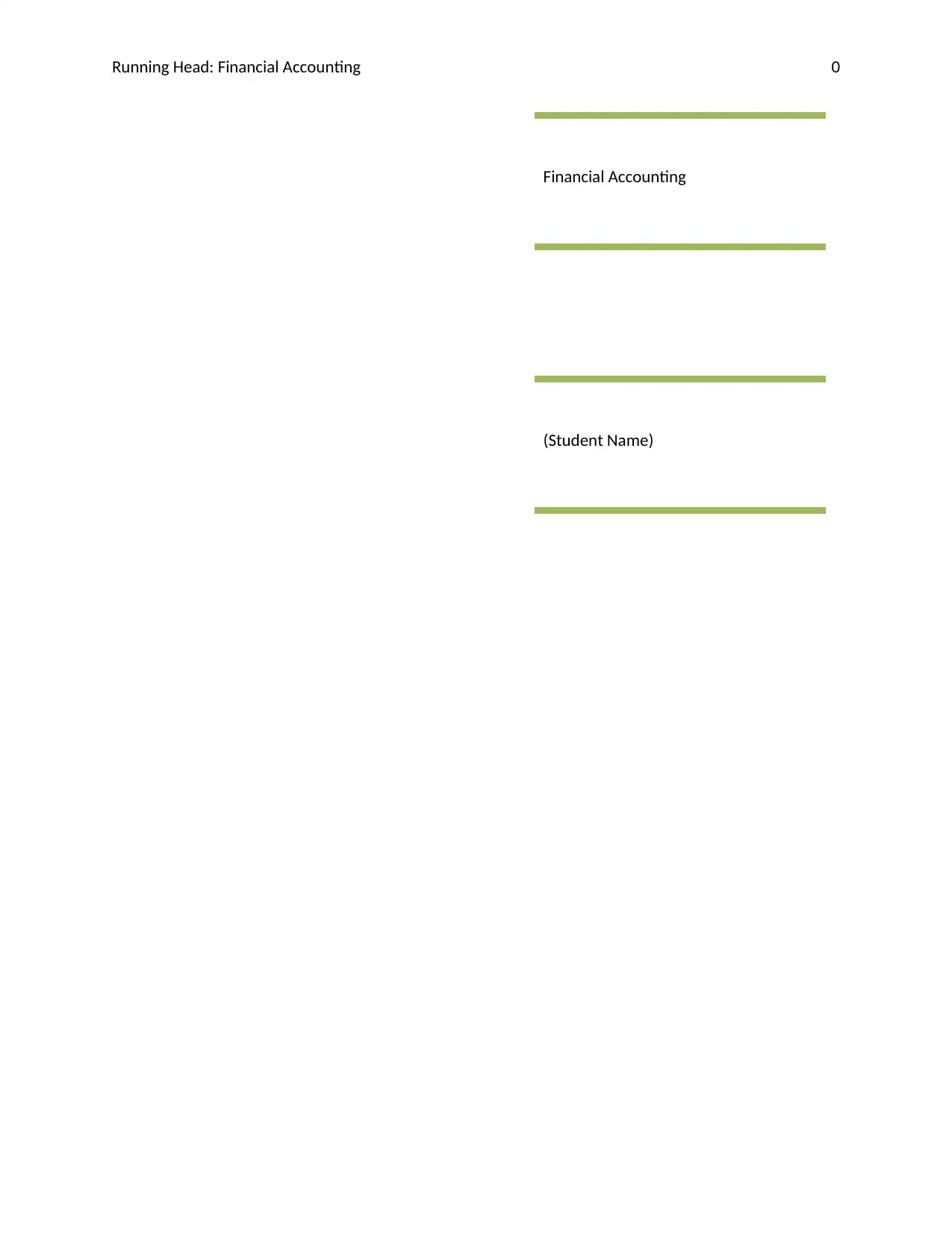
Running Head: Financial Accounting 0
Financial Accounting
(Student Name)
Financial Accounting
(Student Name)
Paraphrase This Document
Need a fresh take? Get an instant paraphrase of this document with our AI Paraphraser
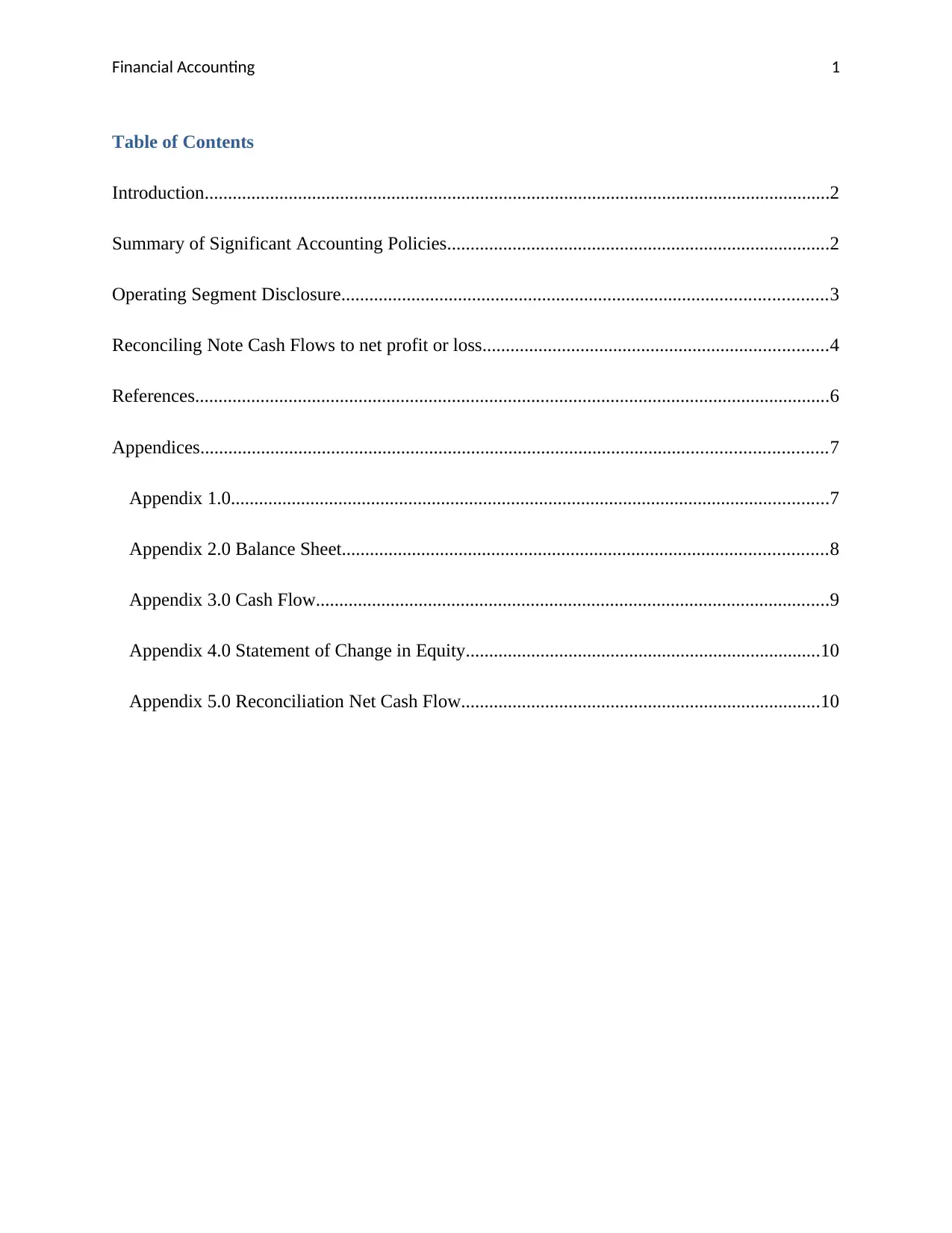
Financial Accounting 1
Table of Contents
Introduction......................................................................................................................................2
Summary of Significant Accounting Policies..................................................................................2
Operating Segment Disclosure........................................................................................................3
Reconciling Note Cash Flows to net profit or loss..........................................................................4
References........................................................................................................................................6
Appendices......................................................................................................................................7
Appendix 1.0................................................................................................................................7
Appendix 2.0 Balance Sheet........................................................................................................8
Appendix 3.0 Cash Flow..............................................................................................................9
Appendix 4.0 Statement of Change in Equity............................................................................10
Appendix 5.0 Reconciliation Net Cash Flow.............................................................................10
Table of Contents
Introduction......................................................................................................................................2
Summary of Significant Accounting Policies..................................................................................2
Operating Segment Disclosure........................................................................................................3
Reconciling Note Cash Flows to net profit or loss..........................................................................4
References........................................................................................................................................6
Appendices......................................................................................................................................7
Appendix 1.0................................................................................................................................7
Appendix 2.0 Balance Sheet........................................................................................................8
Appendix 3.0 Cash Flow..............................................................................................................9
Appendix 4.0 Statement of Change in Equity............................................................................10
Appendix 5.0 Reconciliation Net Cash Flow.............................................................................10
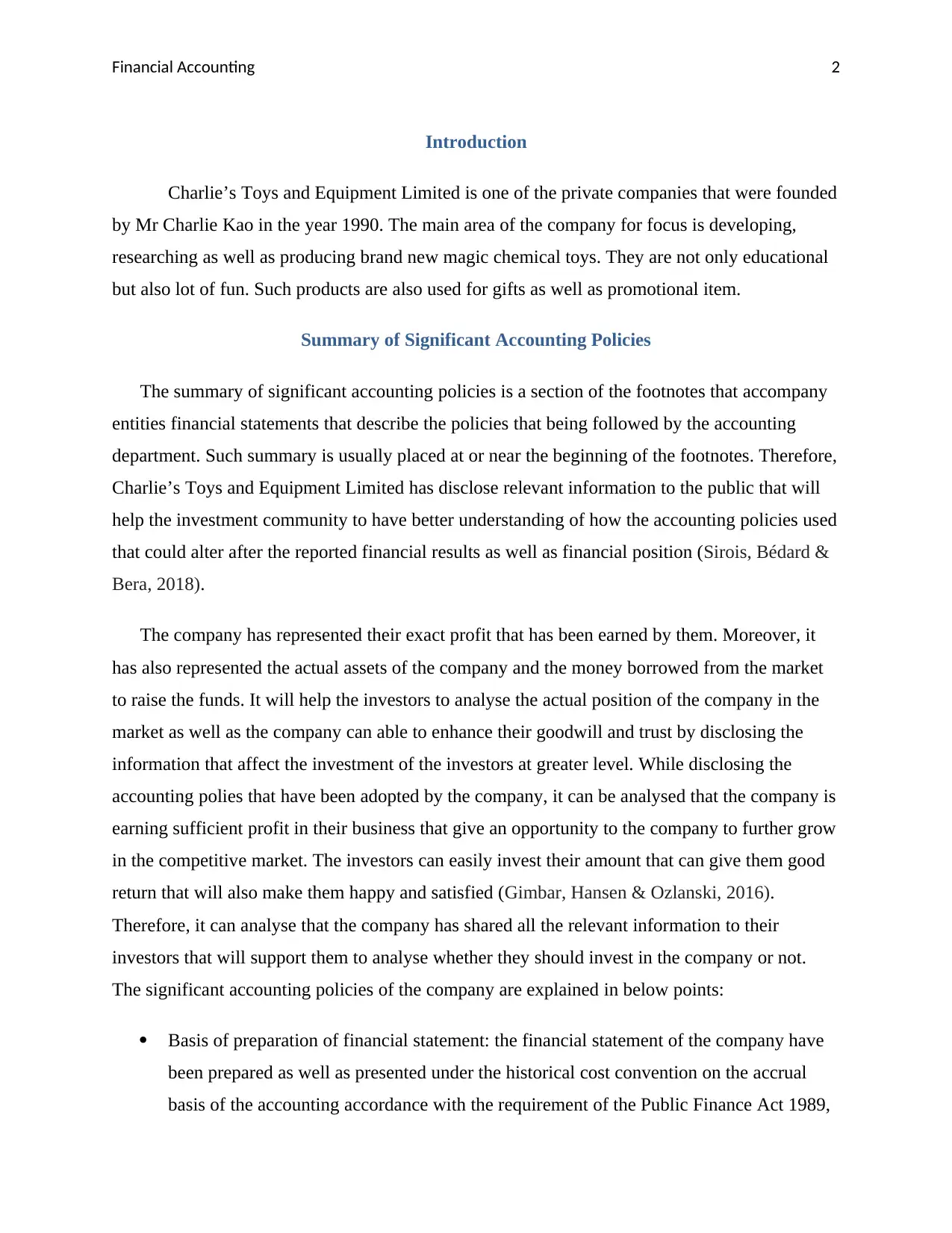
Financial Accounting 2
Introduction
Charlie’s Toys and Equipment Limited is one of the private companies that were founded
by Mr Charlie Kao in the year 1990. The main area of the company for focus is developing,
researching as well as producing brand new magic chemical toys. They are not only educational
but also lot of fun. Such products are also used for gifts as well as promotional item.
Summary of Significant Accounting Policies
The summary of significant accounting policies is a section of the footnotes that accompany
entities financial statements that describe the policies that being followed by the accounting
department. Such summary is usually placed at or near the beginning of the footnotes. Therefore,
Charlie’s Toys and Equipment Limited has disclose relevant information to the public that will
help the investment community to have better understanding of how the accounting policies used
that could alter after the reported financial results as well as financial position (Sirois, Bédard &
Bera, 2018).
The company has represented their exact profit that has been earned by them. Moreover, it
has also represented the actual assets of the company and the money borrowed from the market
to raise the funds. It will help the investors to analyse the actual position of the company in the
market as well as the company can able to enhance their goodwill and trust by disclosing the
information that affect the investment of the investors at greater level. While disclosing the
accounting polies that have been adopted by the company, it can be analysed that the company is
earning sufficient profit in their business that give an opportunity to the company to further grow
in the competitive market. The investors can easily invest their amount that can give them good
return that will also make them happy and satisfied (Gimbar, Hansen & Ozlanski, 2016).
Therefore, it can analyse that the company has shared all the relevant information to their
investors that will support them to analyse whether they should invest in the company or not.
The significant accounting policies of the company are explained in below points:
Basis of preparation of financial statement: the financial statement of the company have
been prepared as well as presented under the historical cost convention on the accrual
basis of the accounting accordance with the requirement of the Public Finance Act 1989,
Introduction
Charlie’s Toys and Equipment Limited is one of the private companies that were founded
by Mr Charlie Kao in the year 1990. The main area of the company for focus is developing,
researching as well as producing brand new magic chemical toys. They are not only educational
but also lot of fun. Such products are also used for gifts as well as promotional item.
Summary of Significant Accounting Policies
The summary of significant accounting policies is a section of the footnotes that accompany
entities financial statements that describe the policies that being followed by the accounting
department. Such summary is usually placed at or near the beginning of the footnotes. Therefore,
Charlie’s Toys and Equipment Limited has disclose relevant information to the public that will
help the investment community to have better understanding of how the accounting policies used
that could alter after the reported financial results as well as financial position (Sirois, Bédard &
Bera, 2018).
The company has represented their exact profit that has been earned by them. Moreover, it
has also represented the actual assets of the company and the money borrowed from the market
to raise the funds. It will help the investors to analyse the actual position of the company in the
market as well as the company can able to enhance their goodwill and trust by disclosing the
information that affect the investment of the investors at greater level. While disclosing the
accounting polies that have been adopted by the company, it can be analysed that the company is
earning sufficient profit in their business that give an opportunity to the company to further grow
in the competitive market. The investors can easily invest their amount that can give them good
return that will also make them happy and satisfied (Gimbar, Hansen & Ozlanski, 2016).
Therefore, it can analyse that the company has shared all the relevant information to their
investors that will support them to analyse whether they should invest in the company or not.
The significant accounting policies of the company are explained in below points:
Basis of preparation of financial statement: the financial statement of the company have
been prepared as well as presented under the historical cost convention on the accrual
basis of the accounting accordance with the requirement of the Public Finance Act 1989,
⊘ This is a preview!⊘
Do you want full access?
Subscribe today to unlock all pages.

Trusted by 1+ million students worldwide
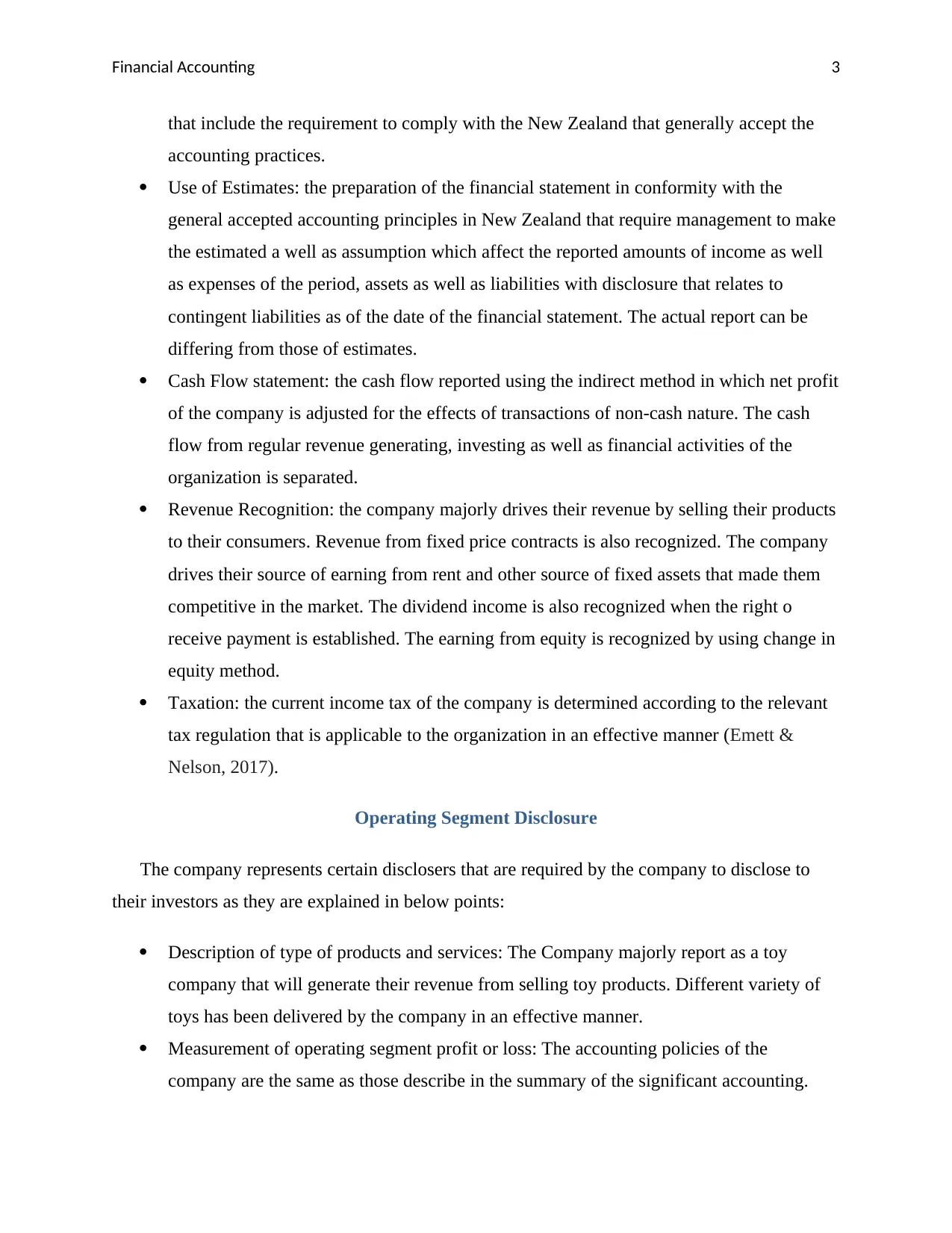
Financial Accounting 3
that include the requirement to comply with the New Zealand that generally accept the
accounting practices.
Use of Estimates: the preparation of the financial statement in conformity with the
general accepted accounting principles in New Zealand that require management to make
the estimated a well as assumption which affect the reported amounts of income as well
as expenses of the period, assets as well as liabilities with disclosure that relates to
contingent liabilities as of the date of the financial statement. The actual report can be
differing from those of estimates.
Cash Flow statement: the cash flow reported using the indirect method in which net profit
of the company is adjusted for the effects of transactions of non-cash nature. The cash
flow from regular revenue generating, investing as well as financial activities of the
organization is separated.
Revenue Recognition: the company majorly drives their revenue by selling their products
to their consumers. Revenue from fixed price contracts is also recognized. The company
drives their source of earning from rent and other source of fixed assets that made them
competitive in the market. The dividend income is also recognized when the right o
receive payment is established. The earning from equity is recognized by using change in
equity method.
Taxation: the current income tax of the company is determined according to the relevant
tax regulation that is applicable to the organization in an effective manner (Emett &
Nelson, 2017).
Operating Segment Disclosure
The company represents certain disclosers that are required by the company to disclose to
their investors as they are explained in below points:
Description of type of products and services: The Company majorly report as a toy
company that will generate their revenue from selling toy products. Different variety of
toys has been delivered by the company in an effective manner.
Measurement of operating segment profit or loss: The accounting policies of the
company are the same as those describe in the summary of the significant accounting.
that include the requirement to comply with the New Zealand that generally accept the
accounting practices.
Use of Estimates: the preparation of the financial statement in conformity with the
general accepted accounting principles in New Zealand that require management to make
the estimated a well as assumption which affect the reported amounts of income as well
as expenses of the period, assets as well as liabilities with disclosure that relates to
contingent liabilities as of the date of the financial statement. The actual report can be
differing from those of estimates.
Cash Flow statement: the cash flow reported using the indirect method in which net profit
of the company is adjusted for the effects of transactions of non-cash nature. The cash
flow from regular revenue generating, investing as well as financial activities of the
organization is separated.
Revenue Recognition: the company majorly drives their revenue by selling their products
to their consumers. Revenue from fixed price contracts is also recognized. The company
drives their source of earning from rent and other source of fixed assets that made them
competitive in the market. The dividend income is also recognized when the right o
receive payment is established. The earning from equity is recognized by using change in
equity method.
Taxation: the current income tax of the company is determined according to the relevant
tax regulation that is applicable to the organization in an effective manner (Emett &
Nelson, 2017).
Operating Segment Disclosure
The company represents certain disclosers that are required by the company to disclose to
their investors as they are explained in below points:
Description of type of products and services: The Company majorly report as a toy
company that will generate their revenue from selling toy products. Different variety of
toys has been delivered by the company in an effective manner.
Measurement of operating segment profit or loss: The accounting policies of the
company are the same as those describe in the summary of the significant accounting.
Paraphrase This Document
Need a fresh take? Get an instant paraphrase of this document with our AI Paraphraser
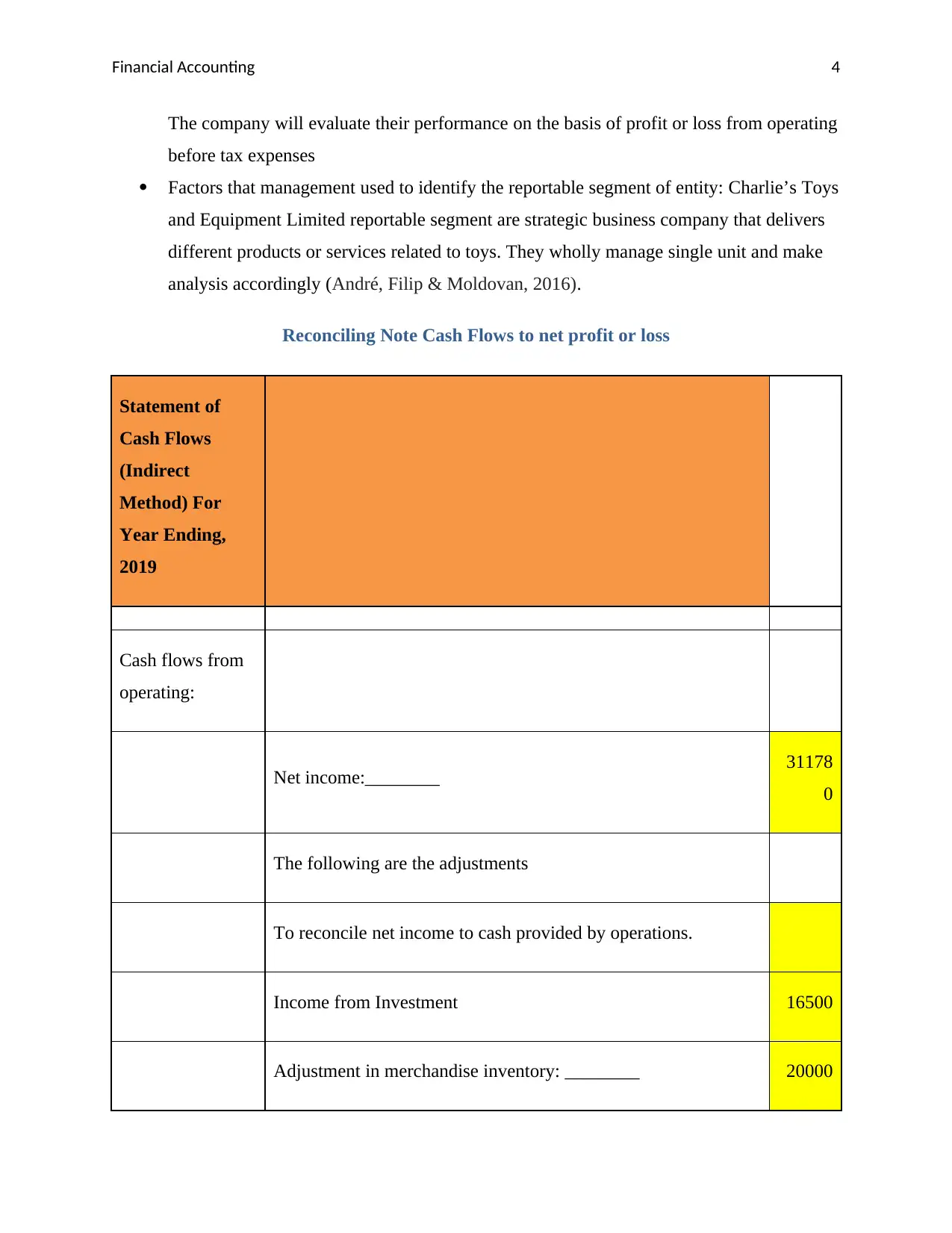
Financial Accounting 4
The company will evaluate their performance on the basis of profit or loss from operating
before tax expenses
Factors that management used to identify the reportable segment of entity: Charlie’s Toys
and Equipment Limited reportable segment are strategic business company that delivers
different products or services related to toys. They wholly manage single unit and make
analysis accordingly (André, Filip & Moldovan, 2016).
Reconciling Note Cash Flows to net profit or loss
Statement of
Cash Flows
(Indirect
Method) For
Year Ending,
2019
Cash flows from
operating:
Net income:________ 31178
0
The following are the adjustments
To reconcile net income to cash provided by operations.
Income from Investment 16500
Adjustment in merchandise inventory: ________ 20000
The company will evaluate their performance on the basis of profit or loss from operating
before tax expenses
Factors that management used to identify the reportable segment of entity: Charlie’s Toys
and Equipment Limited reportable segment are strategic business company that delivers
different products or services related to toys. They wholly manage single unit and make
analysis accordingly (André, Filip & Moldovan, 2016).
Reconciling Note Cash Flows to net profit or loss
Statement of
Cash Flows
(Indirect
Method) For
Year Ending,
2019
Cash flows from
operating:
Net income:________ 31178
0
The following are the adjustments
To reconcile net income to cash provided by operations.
Income from Investment 16500
Adjustment in merchandise inventory: ________ 20000
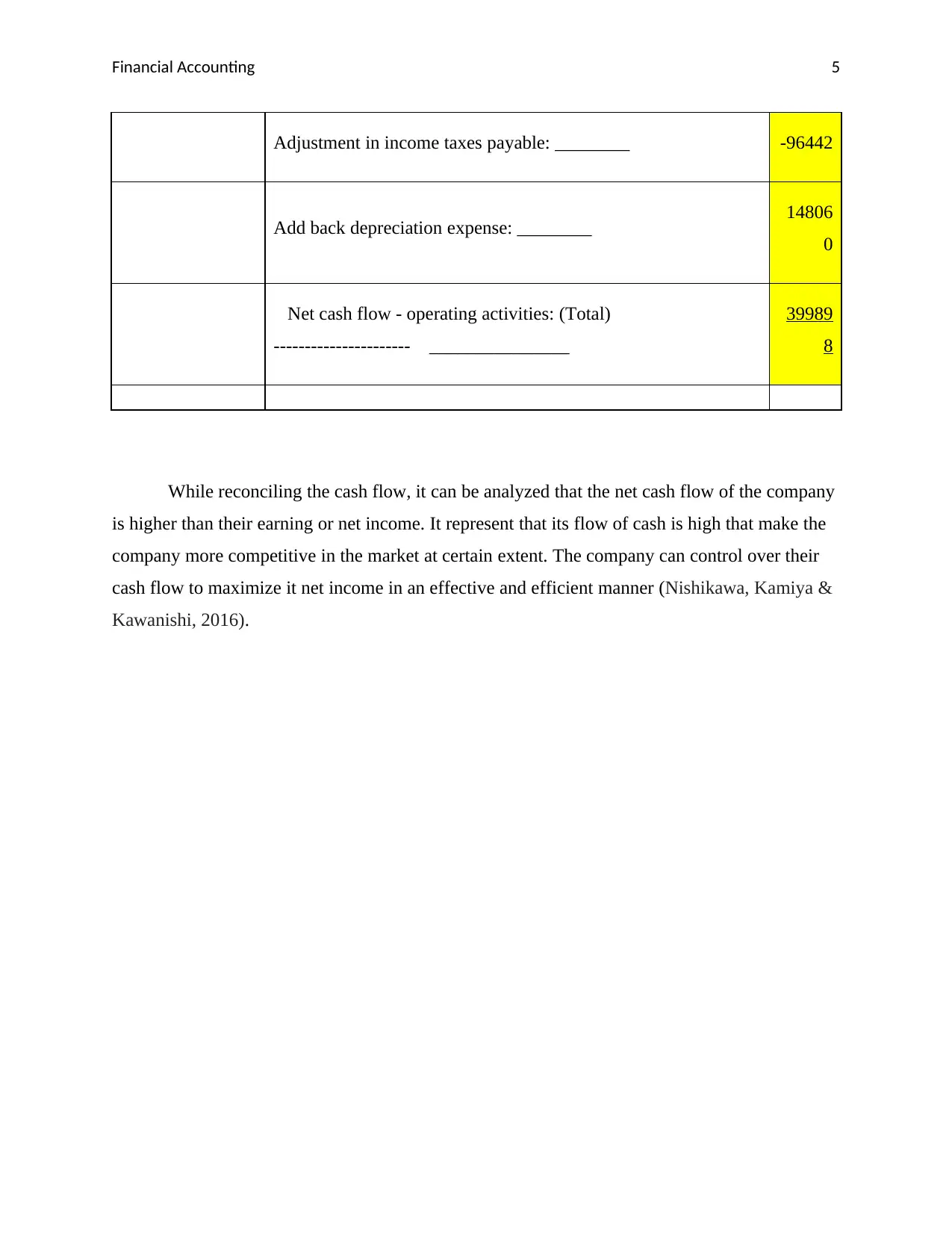
Financial Accounting 5
Adjustment in income taxes payable: ________ -96442
Add back depreciation expense: ________ 14806
0
Net cash flow - operating activities: (Total)
---------------------- _______________
39989
8
While reconciling the cash flow, it can be analyzed that the net cash flow of the company
is higher than their earning or net income. It represent that its flow of cash is high that make the
company more competitive in the market at certain extent. The company can control over their
cash flow to maximize it net income in an effective and efficient manner (Nishikawa, Kamiya &
Kawanishi, 2016).
Adjustment in income taxes payable: ________ -96442
Add back depreciation expense: ________ 14806
0
Net cash flow - operating activities: (Total)
---------------------- _______________
39989
8
While reconciling the cash flow, it can be analyzed that the net cash flow of the company
is higher than their earning or net income. It represent that its flow of cash is high that make the
company more competitive in the market at certain extent. The company can control over their
cash flow to maximize it net income in an effective and efficient manner (Nishikawa, Kamiya &
Kawanishi, 2016).
⊘ This is a preview!⊘
Do you want full access?
Subscribe today to unlock all pages.

Trusted by 1+ million students worldwide
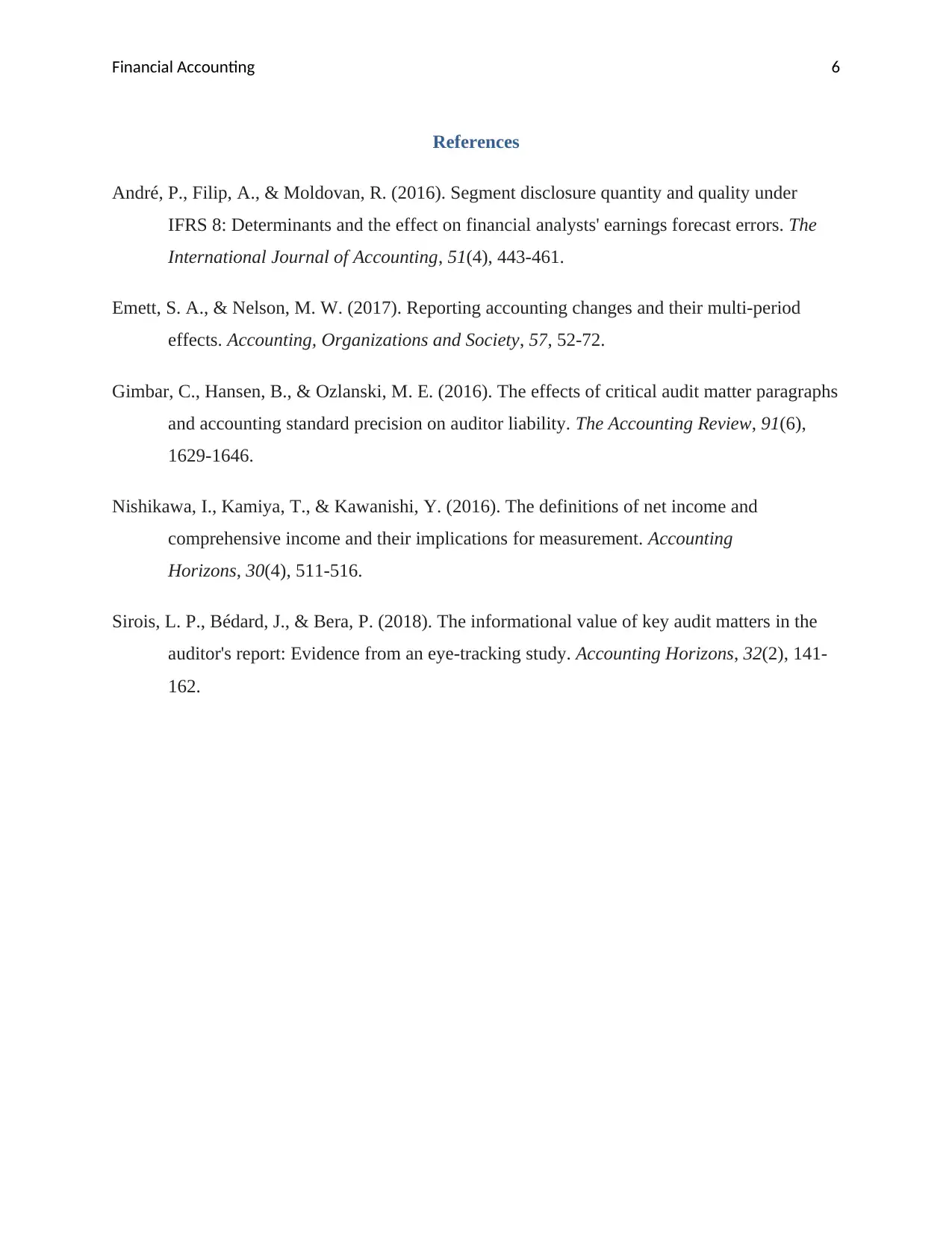
Financial Accounting 6
References
André, P., Filip, A., & Moldovan, R. (2016). Segment disclosure quantity and quality under
IFRS 8: Determinants and the effect on financial analysts' earnings forecast errors. The
International Journal of Accounting, 51(4), 443-461.
Emett, S. A., & Nelson, M. W. (2017). Reporting accounting changes and their multi-period
effects. Accounting, Organizations and Society, 57, 52-72.
Gimbar, C., Hansen, B., & Ozlanski, M. E. (2016). The effects of critical audit matter paragraphs
and accounting standard precision on auditor liability. The Accounting Review, 91(6),
1629-1646.
Nishikawa, I., Kamiya, T., & Kawanishi, Y. (2016). The definitions of net income and
comprehensive income and their implications for measurement. Accounting
Horizons, 30(4), 511-516.
Sirois, L. P., Bédard, J., & Bera, P. (2018). The informational value of key audit matters in the
auditor's report: Evidence from an eye-tracking study. Accounting Horizons, 32(2), 141-
162.
References
André, P., Filip, A., & Moldovan, R. (2016). Segment disclosure quantity and quality under
IFRS 8: Determinants and the effect on financial analysts' earnings forecast errors. The
International Journal of Accounting, 51(4), 443-461.
Emett, S. A., & Nelson, M. W. (2017). Reporting accounting changes and their multi-period
effects. Accounting, Organizations and Society, 57, 52-72.
Gimbar, C., Hansen, B., & Ozlanski, M. E. (2016). The effects of critical audit matter paragraphs
and accounting standard precision on auditor liability. The Accounting Review, 91(6),
1629-1646.
Nishikawa, I., Kamiya, T., & Kawanishi, Y. (2016). The definitions of net income and
comprehensive income and their implications for measurement. Accounting
Horizons, 30(4), 511-516.
Sirois, L. P., Bédard, J., & Bera, P. (2018). The informational value of key audit matters in the
auditor's report: Evidence from an eye-tracking study. Accounting Horizons, 32(2), 141-
162.
Paraphrase This Document
Need a fresh take? Get an instant paraphrase of this document with our AI Paraphraser
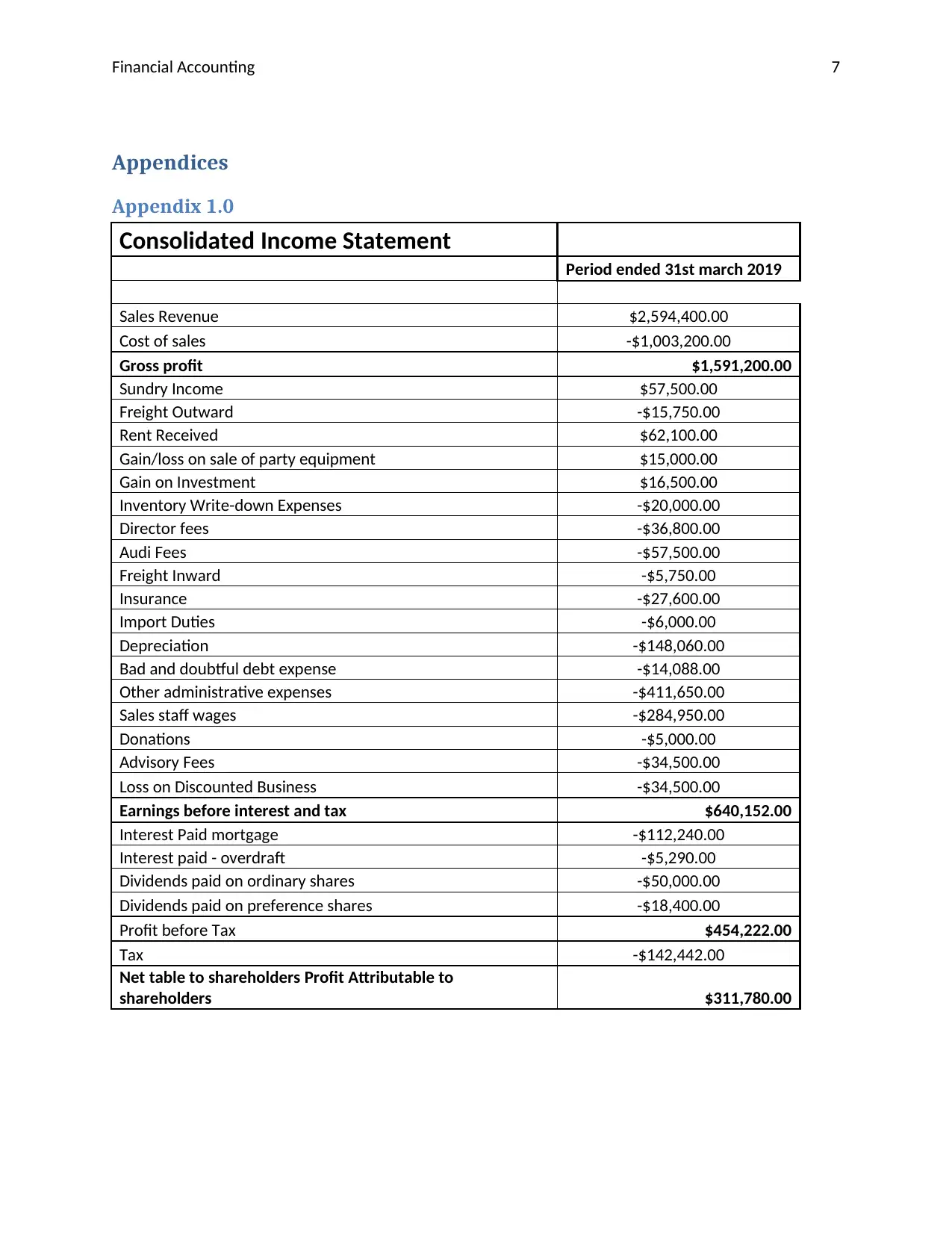
Financial Accounting 7
Appendices
Appendix 1.0
Consolidated Income Statement
Period ended 31st march 2019
Sales Revenue $2,594,400.00
Cost of sales -$1,003,200.00
Gross profit $1,591,200.00
Sundry Income $57,500.00
Freight Outward -$15,750.00
Rent Received $62,100.00
Gain/loss on sale of party equipment $15,000.00
Gain on Investment $16,500.00
Inventory Write-down Expenses -$20,000.00
Director fees -$36,800.00
Audi Fees -$57,500.00
Freight Inward -$5,750.00
Insurance -$27,600.00
Import Duties -$6,000.00
Depreciation -$148,060.00
Bad and doubtful debt expense -$14,088.00
Other administrative expenses -$411,650.00
Sales staff wages -$284,950.00
Donations -$5,000.00
Advisory Fees -$34,500.00
Loss on Discounted Business -$34,500.00
Earnings before interest and tax $640,152.00
Interest Paid mortgage -$112,240.00
Interest paid - overdraft -$5,290.00
Dividends paid on ordinary shares -$50,000.00
Dividends paid on preference shares -$18,400.00
Profit before Tax $454,222.00
Tax -$142,442.00
Net table to shareholders Profit Attributable to
shareholders $311,780.00
Appendices
Appendix 1.0
Consolidated Income Statement
Period ended 31st march 2019
Sales Revenue $2,594,400.00
Cost of sales -$1,003,200.00
Gross profit $1,591,200.00
Sundry Income $57,500.00
Freight Outward -$15,750.00
Rent Received $62,100.00
Gain/loss on sale of party equipment $15,000.00
Gain on Investment $16,500.00
Inventory Write-down Expenses -$20,000.00
Director fees -$36,800.00
Audi Fees -$57,500.00
Freight Inward -$5,750.00
Insurance -$27,600.00
Import Duties -$6,000.00
Depreciation -$148,060.00
Bad and doubtful debt expense -$14,088.00
Other administrative expenses -$411,650.00
Sales staff wages -$284,950.00
Donations -$5,000.00
Advisory Fees -$34,500.00
Loss on Discounted Business -$34,500.00
Earnings before interest and tax $640,152.00
Interest Paid mortgage -$112,240.00
Interest paid - overdraft -$5,290.00
Dividends paid on ordinary shares -$50,000.00
Dividends paid on preference shares -$18,400.00
Profit before Tax $454,222.00
Tax -$142,442.00
Net table to shareholders Profit Attributable to
shareholders $311,780.00
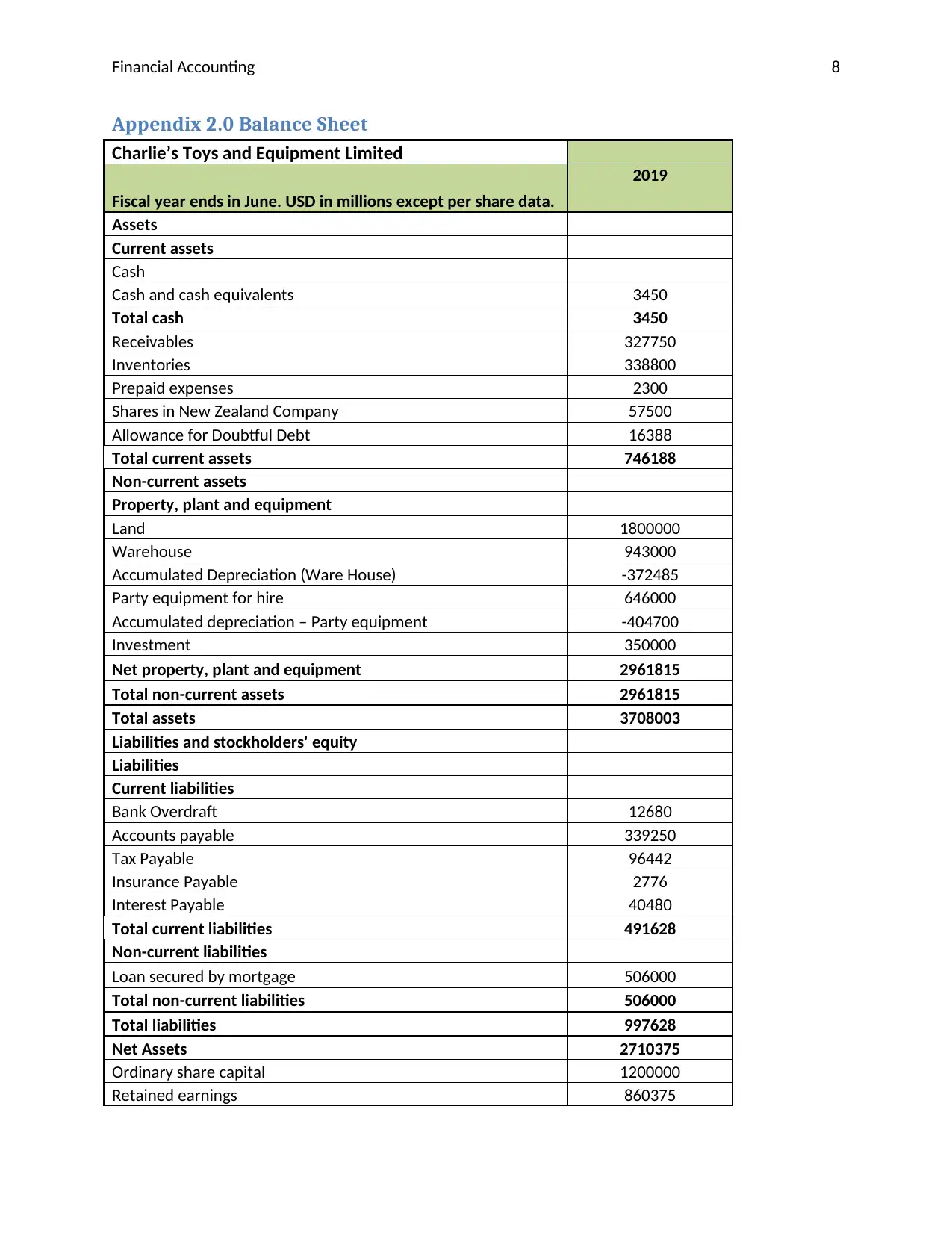
Financial Accounting 8
Appendix 2.0 Balance Sheet
Charlie’s Toys and Equipment Limited
Fiscal year ends in June. USD in millions except per share data.
2019
Assets
Current assets
Cash
Cash and cash equivalents 3450
Total cash 3450
Receivables 327750
Inventories 338800
Prepaid expenses 2300
Shares in New Zealand Company 57500
Allowance for Doubtful Debt 16388
Total current assets 746188
Non-current assets
Property, plant and equipment
Land 1800000
Warehouse 943000
Accumulated Depreciation (Ware House) -372485
Party equipment for hire 646000
Accumulated depreciation – Party equipment -404700
Investment 350000
Net property, plant and equipment 2961815
Total non-current assets 2961815
Total assets 3708003
Liabilities and stockholders' equity
Liabilities
Current liabilities
Bank Overdraft 12680
Accounts payable 339250
Tax Payable 96442
Insurance Payable 2776
Interest Payable 40480
Total current liabilities 491628
Non-current liabilities
Loan secured by mortgage 506000
Total non-current liabilities 506000
Total liabilities 997628
Net Assets 2710375
Ordinary share capital 1200000
Retained earnings 860375
Appendix 2.0 Balance Sheet
Charlie’s Toys and Equipment Limited
Fiscal year ends in June. USD in millions except per share data.
2019
Assets
Current assets
Cash
Cash and cash equivalents 3450
Total cash 3450
Receivables 327750
Inventories 338800
Prepaid expenses 2300
Shares in New Zealand Company 57500
Allowance for Doubtful Debt 16388
Total current assets 746188
Non-current assets
Property, plant and equipment
Land 1800000
Warehouse 943000
Accumulated Depreciation (Ware House) -372485
Party equipment for hire 646000
Accumulated depreciation – Party equipment -404700
Investment 350000
Net property, plant and equipment 2961815
Total non-current assets 2961815
Total assets 3708003
Liabilities and stockholders' equity
Liabilities
Current liabilities
Bank Overdraft 12680
Accounts payable 339250
Tax Payable 96442
Insurance Payable 2776
Interest Payable 40480
Total current liabilities 491628
Non-current liabilities
Loan secured by mortgage 506000
Total non-current liabilities 506000
Total liabilities 997628
Net Assets 2710375
Ordinary share capital 1200000
Retained earnings 860375
⊘ This is a preview!⊘
Do you want full access?
Subscribe today to unlock all pages.

Trusted by 1+ million students worldwide
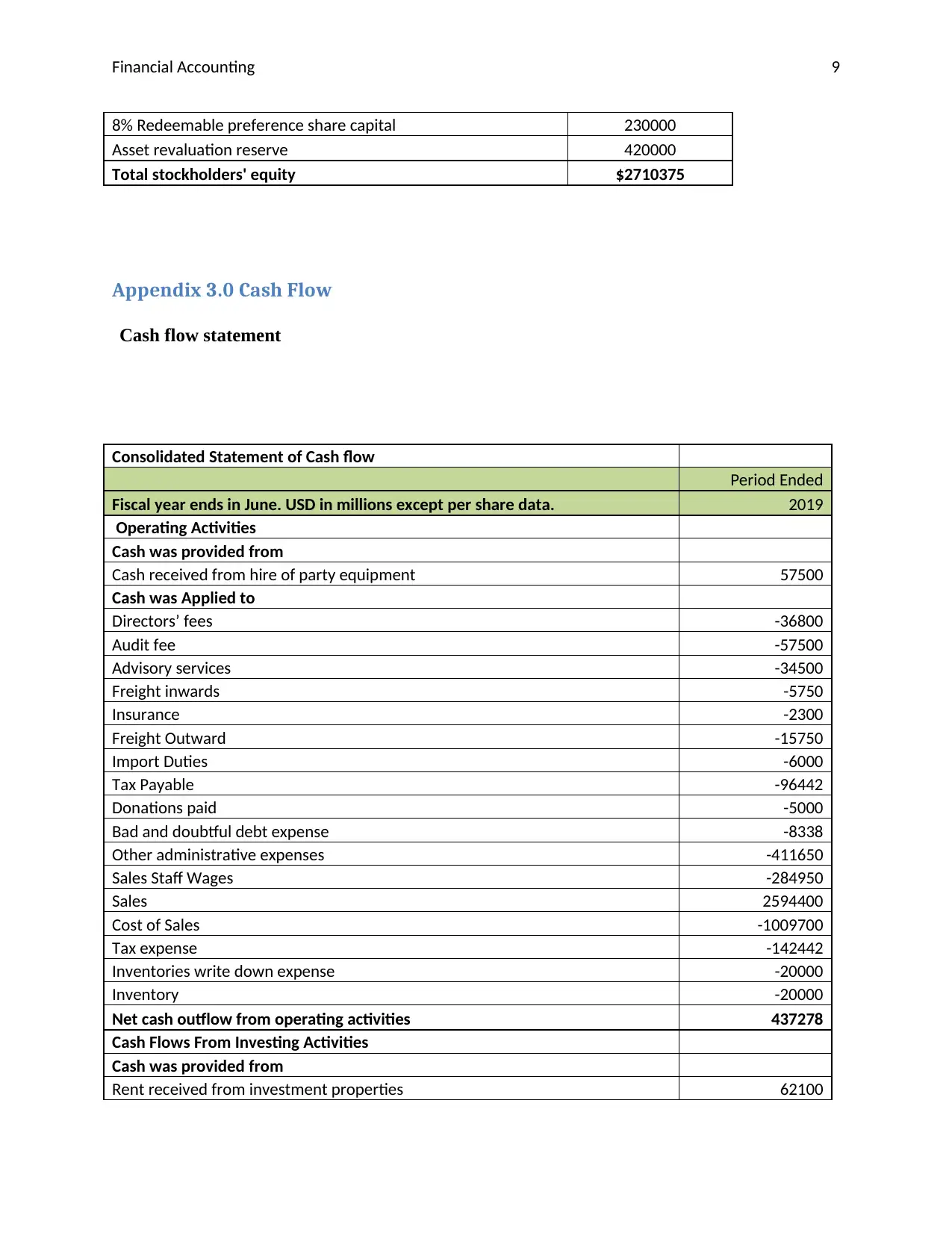
Financial Accounting 9
8% Redeemable preference share capital 230000
Asset revaluation reserve 420000
Total stockholders' equity $2710375
Appendix 3.0 Cash Flow
Cash flow statement
Consolidated Statement of Cash flow
Period Ended
Fiscal year ends in June. USD in millions except per share data. 2019
Operating Activities
Cash was provided from
Cash received from hire of party equipment 57500
Cash was Applied to
Directors’ fees -36800
Audit fee -57500
Advisory services -34500
Freight inwards -5750
Insurance -2300
Freight Outward -15750
Import Duties -6000
Tax Payable -96442
Donations paid -5000
Bad and doubtful debt expense -8338
Other administrative expenses -411650
Sales Staff Wages -284950
Sales 2594400
Cost of Sales -1009700
Tax expense -142442
Inventories write down expense -20000
Inventory -20000
Net cash outflow from operating activities 437278
Cash Flows From Investing Activities
Cash was provided from
Rent received from investment properties 62100
8% Redeemable preference share capital 230000
Asset revaluation reserve 420000
Total stockholders' equity $2710375
Appendix 3.0 Cash Flow
Cash flow statement
Consolidated Statement of Cash flow
Period Ended
Fiscal year ends in June. USD in millions except per share data. 2019
Operating Activities
Cash was provided from
Cash received from hire of party equipment 57500
Cash was Applied to
Directors’ fees -36800
Audit fee -57500
Advisory services -34500
Freight inwards -5750
Insurance -2300
Freight Outward -15750
Import Duties -6000
Tax Payable -96442
Donations paid -5000
Bad and doubtful debt expense -8338
Other administrative expenses -411650
Sales Staff Wages -284950
Sales 2594400
Cost of Sales -1009700
Tax expense -142442
Inventories write down expense -20000
Inventory -20000
Net cash outflow from operating activities 437278
Cash Flows From Investing Activities
Cash was provided from
Rent received from investment properties 62100
Paraphrase This Document
Need a fresh take? Get an instant paraphrase of this document with our AI Paraphraser
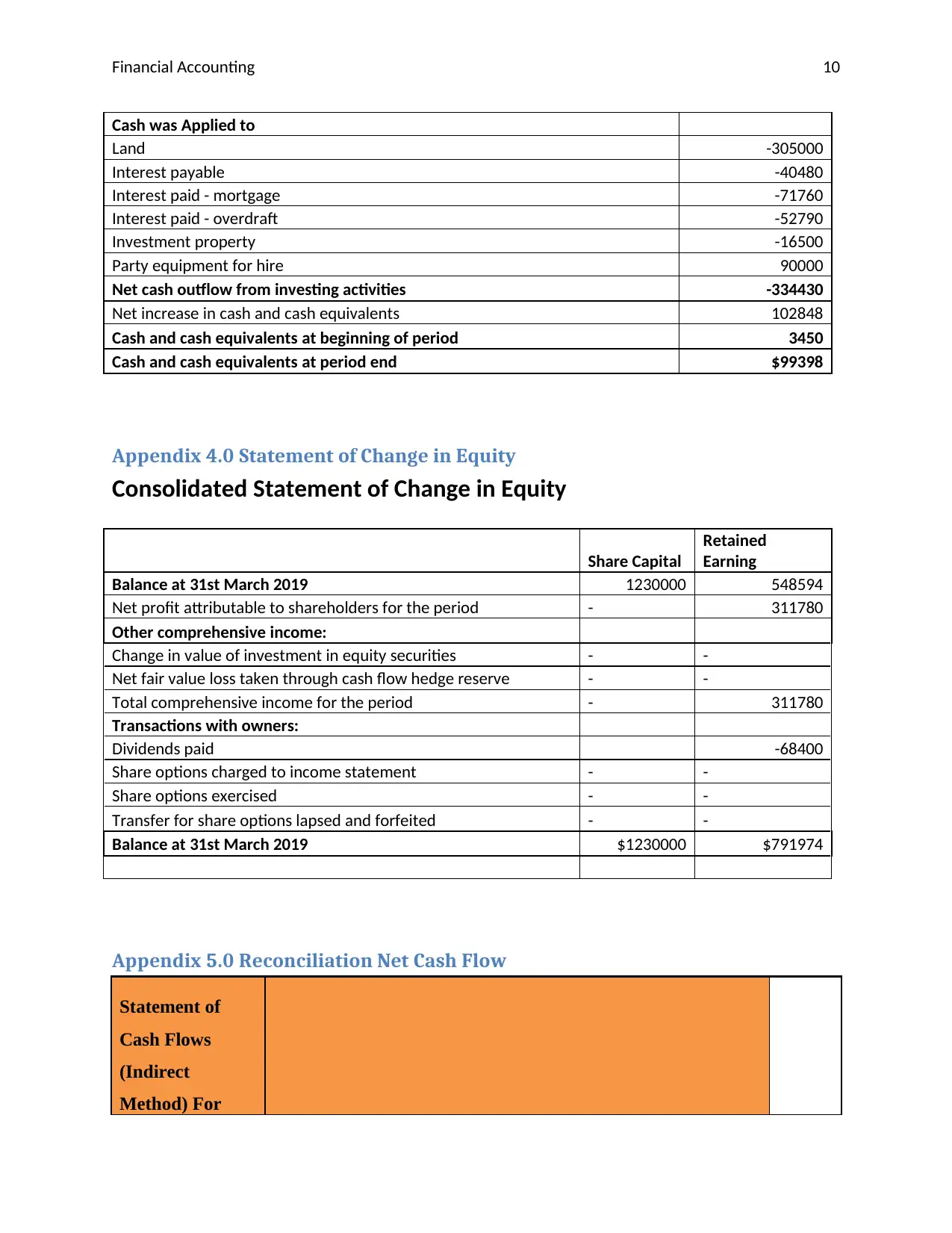
Financial Accounting 10
Cash was Applied to
Land -305000
Interest payable -40480
Interest paid - mortgage -71760
Interest paid - overdraft -52790
Investment property -16500
Party equipment for hire 90000
Net cash outflow from investing activities -334430
Net increase in cash and cash equivalents 102848
Cash and cash equivalents at beginning of period 3450
Cash and cash equivalents at period end $99398
Appendix 4.0 Statement of Change in Equity
Consolidated Statement of Change in Equity
Share Capital
Retained
Earning
Balance at 31st March 2019 1230000 548594
Net profit attributable to shareholders for the period - 311780
Other comprehensive income:
Change in value of investment in equity securities - -
Net fair value loss taken through cash flow hedge reserve - -
Total comprehensive income for the period - 311780
Transactions with owners:
Dividends paid -68400
Share options charged to income statement - -
Share options exercised - -
Transfer for share options lapsed and forfeited - -
Balance at 31st March 2019 $1230000 $791974
Appendix 5.0 Reconciliation Net Cash Flow
Statement of
Cash Flows
(Indirect
Method) For
Cash was Applied to
Land -305000
Interest payable -40480
Interest paid - mortgage -71760
Interest paid - overdraft -52790
Investment property -16500
Party equipment for hire 90000
Net cash outflow from investing activities -334430
Net increase in cash and cash equivalents 102848
Cash and cash equivalents at beginning of period 3450
Cash and cash equivalents at period end $99398
Appendix 4.0 Statement of Change in Equity
Consolidated Statement of Change in Equity
Share Capital
Retained
Earning
Balance at 31st March 2019 1230000 548594
Net profit attributable to shareholders for the period - 311780
Other comprehensive income:
Change in value of investment in equity securities - -
Net fair value loss taken through cash flow hedge reserve - -
Total comprehensive income for the period - 311780
Transactions with owners:
Dividends paid -68400
Share options charged to income statement - -
Share options exercised - -
Transfer for share options lapsed and forfeited - -
Balance at 31st March 2019 $1230000 $791974
Appendix 5.0 Reconciliation Net Cash Flow
Statement of
Cash Flows
(Indirect
Method) For
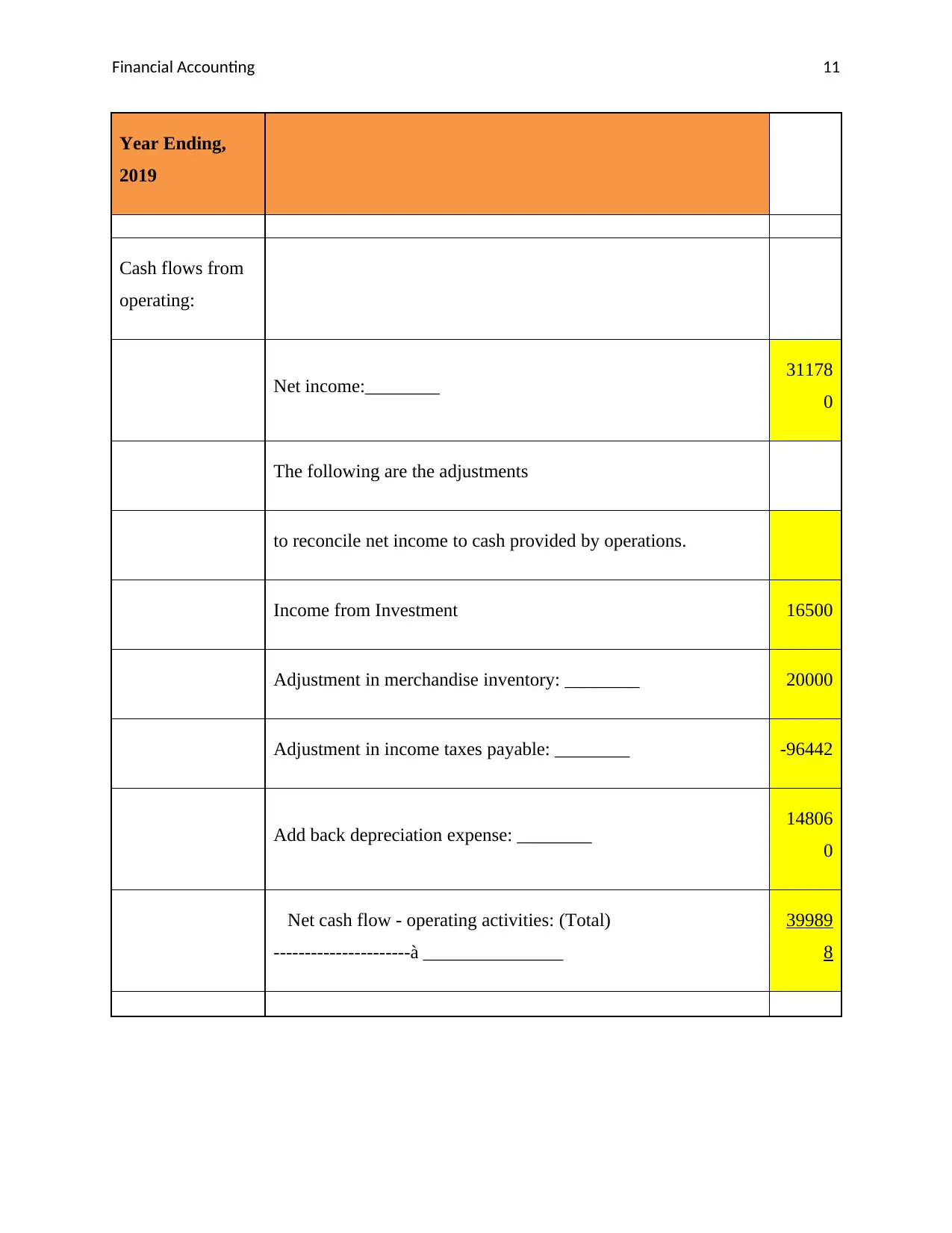
Financial Accounting 11
Year Ending,
2019
Cash flows from
operating:
Net income:________ 31178
0
The following are the adjustments
to reconcile net income to cash provided by operations.
Income from Investment 16500
Adjustment in merchandise inventory: ________ 20000
Adjustment in income taxes payable: ________ -96442
Add back depreciation expense: ________ 14806
0
Net cash flow - operating activities: (Total)
----------------------à _______________
39989
8
Year Ending,
2019
Cash flows from
operating:
Net income:________ 31178
0
The following are the adjustments
to reconcile net income to cash provided by operations.
Income from Investment 16500
Adjustment in merchandise inventory: ________ 20000
Adjustment in income taxes payable: ________ -96442
Add back depreciation expense: ________ 14806
0
Net cash flow - operating activities: (Total)
----------------------à _______________
39989
8
⊘ This is a preview!⊘
Do you want full access?
Subscribe today to unlock all pages.

Trusted by 1+ million students worldwide
1 out of 12
Related Documents
Your All-in-One AI-Powered Toolkit for Academic Success.
+13062052269
info@desklib.com
Available 24*7 on WhatsApp / Email
![[object Object]](/_next/static/media/star-bottom.7253800d.svg)
Unlock your academic potential
Copyright © 2020–2025 A2Z Services. All Rights Reserved. Developed and managed by ZUCOL.





